
 |
Previous | SkunkHaven.Net Index | Next |
Many skunks suffer from rectal prolapse, a condition where the rectum and/or lower intestines protrude from the body. Often this can be insignificant and not require first aid or a trip to the vet. Occasionally the condition persists or worsens in a short time, in young or active skunks this can lead to infection or cause severe damage to the exposed parts.
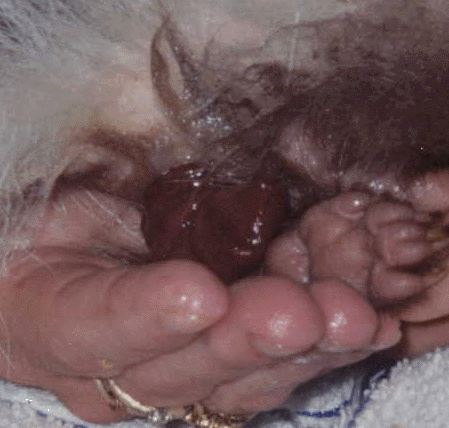 |
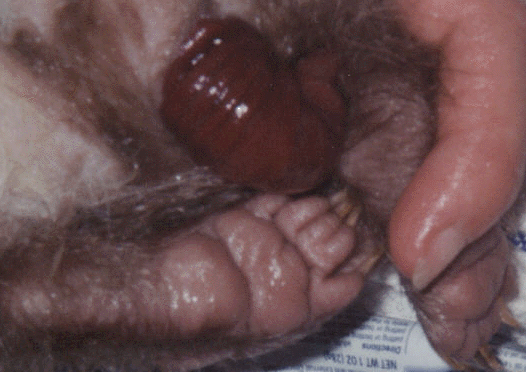 |
| Rectal Prolapse - Photos by SkunkHaven™ | |
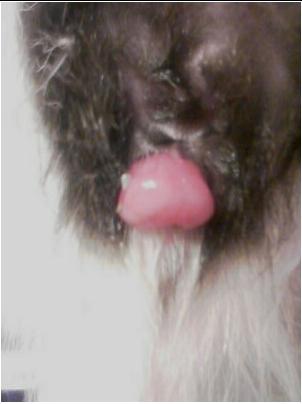 | |
| Prolapse - Photo by Ian Biaza | |
If you are unsure how long the skunk has been experiencing the problem or there is obvious bleeding or damage to the rectum or intestines, seek a vet's advice and/or treatment immediately.
The typical causes of prolapse are diarrhea in young skunks and chronic diarrhea in adult skunks, constipation, improper descenting, worms or other GI parasites, viruses and bacteria. If the problem is worms the skunk will push excessively to get them out of its system. This may lead to successive recurrence of the prolapse until all of the worms are passed.
You will need - nail clippers, a large towel or small blanket, warm water, Preparation-H, lubricant gel (KY Jelly or Vaseline), and a comfortable place to sit.
Watch for recurrence for the next several hours and check the skunk regularly over the next few days.
If this does not work, get to a vet. The vet will have to put a purse-string stitch in for a few days to hold the intestines in place while the insides heal. Change to a high liquid diet of broth, soups, pureed baby food, etc., while the purse-string is in place.
Keep the skunk calm and separate from other animals and children, possibly for several days.
Change the skunk's diet - NO fruits or fresh veggies for one-to-two weeks, feed cooked vegetables, pasta, high quality dog food, cooked chicken or turkey, cereals, pureed baby food, canned pumpkin, tofu, etc. Start back on fresh veggies and fruits slowly, make sure food is cut in small pieces. High fiber foods and supplements like Metamucil may help prevent the straining which can lead to prolapse.
If there is a risk of infection use Panalog (from vets), an antibiotic ointment, applied inside the rectum after the intestines are back in. A small amount will help prevent infection and aid in reducing that inflammated bowel so that it will reduce and return to it's proper place.
Also to help stop from straining get Centrine tablets from the vet; suggested dose for a skunk is 1/2 tablet twice daily for two to three days.
An old remedy is to wet the rectum/intestines with warm water, then coat with sugar; it will shrink the prolapse. You can also make a thin sugar paste and coat the exposed rectum. This has shown excellent results.
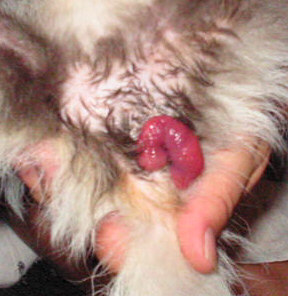 |
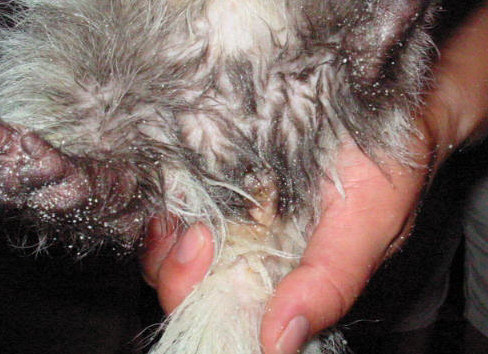 |
| Before and after photos of prolapse and 30 minutes after the sugar paste was applied. Photos by Carol Infalt. | |
Another method is a pan of COLD (Ice) water. Stick the skunk's butt in water and the intestines should go back in (this may not work in all cases).
RAW CHICKEN BONE FOUND TO BE THE CAUSE OF PROLAPSES
My new son, Ralphael, joined our family on Christmas Eve. At 7 months he weighed in at 5 pounds and had had a difficult beginning of life. He had been switched around from one home to another until he ended up living with a college student. Fortunately the student admitted he did not have the time or interest to deal with this little skunk.
I had heard through a friend of his plight and even though we have a good size family of critters, one of which being a female skunk, Shelby, I realized this little one was destined to be a member of our group.
When I picked him up I had been told that he was prolapsing. From the time he entered our home he had 1-2 prolapses daily and rectal bleeding. Trying to be a good mom, I went through all the possible issues, changing diet, trying to reduce stress, using topical antibiotics and hemmoroid meds, etc, etc. I discussed with several people the prospect of having the surgical stitch put in to help him but was holding that off as a last resort.
He had accupuncture twice a week and was found to be soy intolerant and vitamin and mineral deficient. He was neutered about two weeks after he arrived and figured that did add to his stress so I would continue to work with him using less invasive procedures. Also at the time of neutering, His blood work had mostly come back into the normal range which made me hopeful that the prolapses would come to an end.
Also at the time of his neutering, he had a second fecal check since arriving at our home and he came out clear. Despite the clear fecals, I considered another worming since I was told some parasites may not show up on the tests. I held off on that too since I did not want to cause any more physical stress right away. I started using Rescue Remedy, an all natural product that helps reduce stress, and this seemsed to make him more calm, but the prolapeses continued.
Initially I had switched him to a soft, easy to digest diet hoping to relieve the pressure he was exerting which might be causing the prolapses but diarrrea and prolapses continued. Talking to others and figuring the diarrea might be causing the problem. I switched him to a high fiber diet, hoping that a more firm stool would stop the prolapses. Because of the constant bleeding, I also started antibiotics from the vet to avoid any possible infection. Within two days after starting the high fiber diet, when I was helping him get his prolapse back in, I felt something sharp and hard. I feared that he might have ingested a piece of plastic. I called and made arrangements for x-rays to check for any obstructions. The following night when I helped him with his prolapse it was smooth and he helped. My first reaction was that he was learning how to work with me to get the proplases back in.
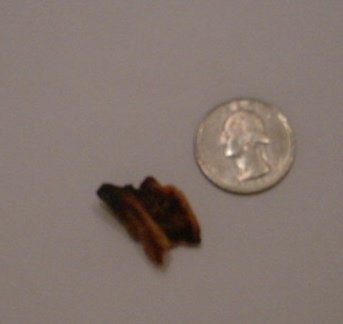 |
When I was picking up his potty pad, I found a piece of a shaft of chicken leg bone next to the drops of blood. The high fiber diet helped him push out this bone that had been inside his body for 5-6 weeks. It was dark so I though it must have been cooked. The following day he postured up in a hump like something hurt in his tummy but had no prolapse..the first day since he arrived at his new home.
I contacted the person who had him before coming to me and he said that he had given Ralphie raw chicken legs, with the bone still in the meat. When I went to the vet he checked the bone and took an x-ray of it when he x-rayed Ralphie. Fortunately Ralphie appeared to be clear of any more obstructions. I asked about the bone being dark since the previous owner said the bones he fed were raw. The vet said that the bone was dark because the outer layer had been dissolved by stomach acid and the pourousness of the bone had absorbed some of the blood.
The bone appeared one week ago today and Ralpheal is a different boy. There has been no more prolapses and he is beginning to play and wanting to be around the rest of us much more. For the last two nights he even clmbed up on the bed and slept cuddled next to me. It was also fortunate that we did not choose the surgical stitch early on or Ralphael would have had a much harder time, if he could have at all, pushed out that bone fragment.
I realize everyone has their own opinion and I do not claim to be highly knowledgeable on the subject. However, after this experience, watching Ralphie suffer so from the ingestion of the bone only confirms my belief in never giving to any of my fuzzy or other family members, or any of my wild friends either, bones or anything that can be broken and become sharp that they could swallow.
Respectfully Submitted,
Rapheal's mom
P.S. It is said there are no coincidences. When I went to pick up Ralphie, he was living several hundred miles away from our home. I did not take any of my other fuzzy family with me so on the ride home Ralphie and I had some one-on-one time together. He had originally been named Jack but I did not feel it fit him. We went over lots of names and we came up with Raphael, Ralphie for short, and he seemed quite pleased when I refered to him with that name. I figured given his background he needed an angel to look after him. When I looked the name Raphael up to be sure I spelled it correctly for his ID tag, I found the definition. A definition of Raphael is Hebrew for "God please heal." Given his ordeal, his name turned out to be an unconscious prayer that was answered.... We sure love this boy!
This started out as a simple prolapse. This youngster was in with other yearling kits and began prolapsing frequently.
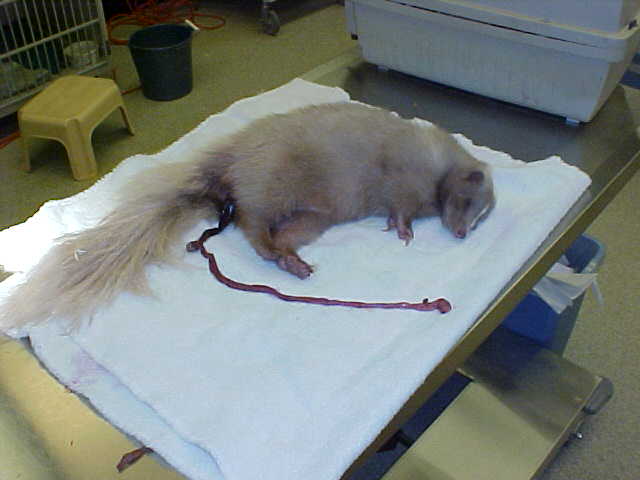 |
This is an extreme case where the other skunks pulled and chewed at the colon, rectum, and intestines until the poor skunk was injured to the point it could not be saved.
Care should be taken with any skunk known to have prolapse problems. They should be separated from other animals as soon as prolapse is noticed and should remain separated for several days after the prolapse incidents stop
One of our members does this for her rectal prolasp ..
© 2001-2025 Skunk Haven™ Skunk Rescue, Shelter, and Education, Inc.
Revised 07/11/17 (SRS)
 |
||
| Previous | SkunkHaven.Net Index | Next |
|
|
Validate HTML 4.01 |